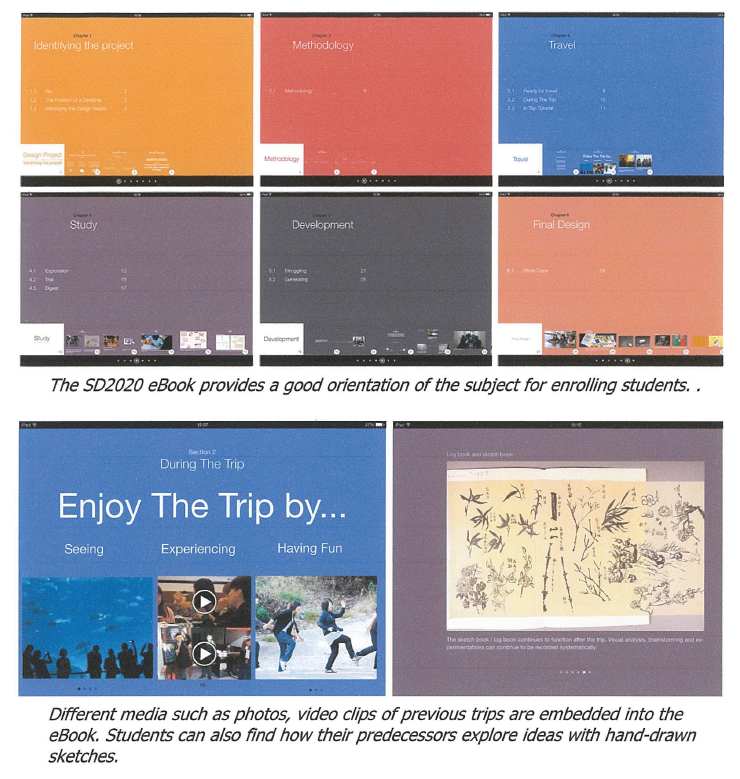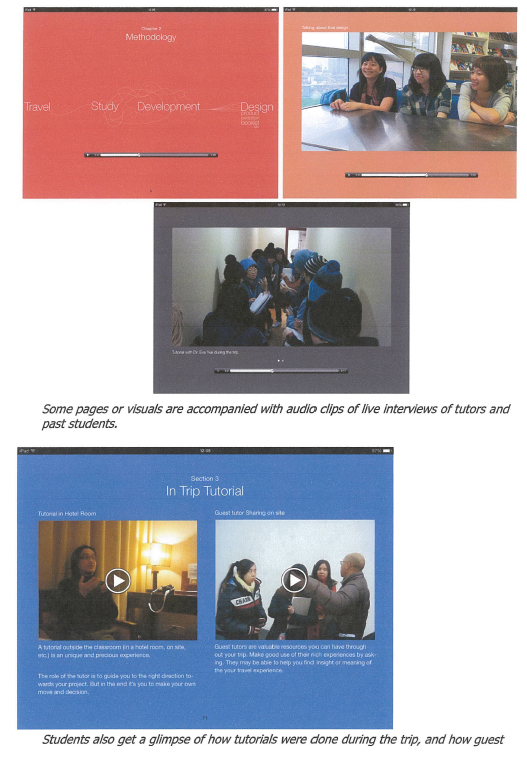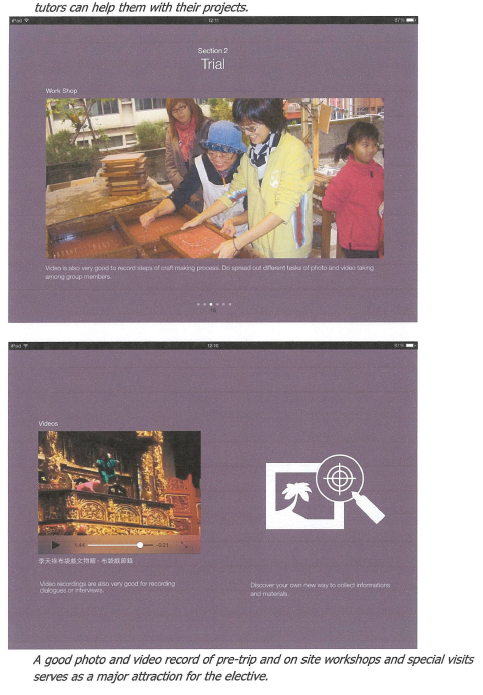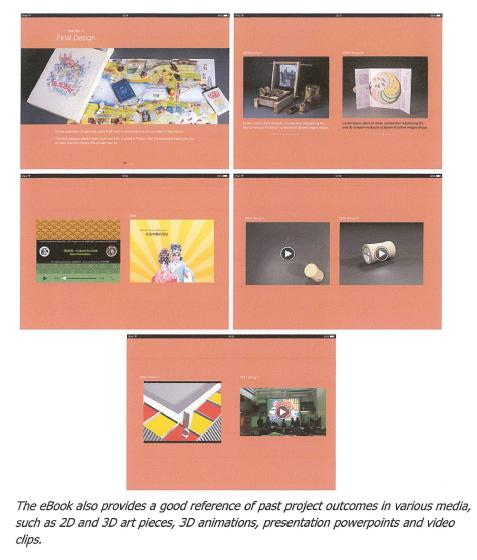
|
![]() : Celebrating Field Trip Studies - Enhancing and Popularizing Design Learning and Teaching beyond a School Environment
: Celebrating Field Trip Studies - Enhancing and Popularizing Design Learning and Teaching beyond a School Environment
Description
This e-book serves a guide book for the study of the subject SD2020. The content and design were based on the findings of the two sets of questionnaires during the pre-trip and post-trip stages of previous field trips. This e-book was designed to equip students with a right attitude and mindsent for the projects. There are in total six chapters and they are:
- Identifying the project
- Methodology
- Travel
- Study
- Development
- Final Design




Evaluation
In order to colelct feedback and assess the effectiveness, apart from the observations made during the trip, two sets of student questionnaires were conducted before and after the trip. For the design and the findings of the questionnaires, please click here to read the report.
Results and Findings
On the whole, the research project was done satisfactorily, supported with results and evidences from the students' performance during the trip and in their project work. Feedback from students was also directly collected via two sets of questionnaire, which is a part of the usual quality assurance measures for the subject. Additional questions referring to the two project outcomes - eBook and Website were inserted for students to express their reactions directly.
All of these helped to produce useful data and findings for future references or potential implementations in the future - for study trip subjects, as well as similar subjects that require students to work in the field.
The respond rate of the questionnaires was like this;
- Pre trip 100%
- Post trip N78%
As the application of the two digital learning tools was only voluntary, the rate of usage and participation indicated from the questionnaire was not as high as expected - as can be found out from the attached results and analysis of the questionnaires. But, for the student who did use them, their feedback is positive, which is very supportive to the aims and directions of the research project.
The research also generated student work samples, and gained experiences of how online platforms can be utilized in out-of-c1assroom education scenarios, as both for its benefits and shortages, particularly in design fields. The experience and knowledge gained from knowing the patterns and habits of how tailor-made online learning and teaching media are being applied in such subjects are particularly valuable and useful as reference as well.
A range of observations, results, evaluations and recommendations have been drawn down from the processes and listed in below for reference.
Consolidated observations from the pilot run of the digital learning tools - eBook, website and database;
Nature of the study trip subjects
As observed from past years, this particular study trip subject that the research project used for sampling reactions from students is heavily focused on the contextual sides of design education - like research methodologies, design thinking, cultural, historical and social aspects of design. These are the soft sides of the design discipline that the HD students are relatively lagging behind in their curricula, as the nature of the HD programme place more emphases on the operational and technical sides. Hence, the students usually need a lot more help from the tutors, and they have to put in extra efforts and time to progress through the subject when compared to other subjects. In the past, some may not even get past that stage. Now with the electronic guide book developed through the project, it is hoped that the newcomers can be able to grasp these essence of the subject more effectively.
Understanding of the Design Process
Also based on past experience, HD students are generally weaker in the soft skills of design - like research, analysis, generation of insight and ideation. They often felt very uncomfortable and almost at a loss when faced with uncertain situations, or when encountering open-ended interpretations. They simply wanted to make something instead of try their best to investigate into some issues/topics, so that there may be possibilities to generate some new insights or interpretations for certain cultural related issues that they encounter. Their deficiency in the understanding of the importance of cultivation of creativity and design thinking abilities over technical skills affects their involvement in the subject as well as using the digital learning tools - which are designed for the enrichment of their design processes.
Abilities to contextualize for designing
From observation, this group of HD students - from HDMDTand HDPI"f, who register for the study trip: S02020 Culture Revisit, very much remained in a lower level understanding of design learning - instructional, as they were constantly looking for model answers so as to move onto making stage of their own designs. Perhaps they are used to being told about what to do step-by-step, Or, their understanding of design/designing is dependent on the making/production phases, rather than identifying/defining/re-defining design problems; and consequently solving these with innovative solutions. Being students coming from the HOs, most of the students who took the subject were too focused in the operation or practical sides of design that have been introduced in the subject - like hands-on techniques such as sketching, printmaking or information gathering; but are weak in contextualization - such as research, analyzing, interpretation, or generation of concepts or ideas for further development.
Group dynamics
Since the project inside the subject required students to be formed into small teams with members from different programmes - HOMOT and HOPfr, the group dynamics has influenced the progress and therefore outcomes from the projects. Some of the teams were not working as smoothly as they should have been; because of the clashing of characters, or, weak interpersonal skills. Some students even went as far as, neglected the group work and therefore affected the performance of the group as a whole.
Recommendations
Assignment requirements and student abilitiesAssignment requirements and student abilities
The students in the past year were comparatively not used to and therefore weak in grasping of the nature of such a content-emphasized and culture related subject. They were more anxious on identifying their subject matters, and focused their emphasis on the development of a specific design piece for submission. So, destinations on the itinerarywere more obvious targets for their projects. And the development of their design processes like founding references from the archives of student work - which are not linked to the itineraries of this trip, and exploring different modes of project developments were not their primary concerns till very late stages of the project which is close to their deadline. Hence the online platform was being visited less often than anticipated.
Recommendation:
1. Structure the assignment or project brief may have to include the materials and supports provided by the online platform as integral parts of the learning and teaching resources, etc. Or, maybe even demand the materials from the online tools to be used as sources of learning.
2. Or, perhaps simple tasks have to be done via the website or eBook so that students can be encouraged to experience so as to equip themselves with before setting off for the trip.
Timing of the launch of the website
Due to unforeseeable technical hiccups, the web site was only ready and launched not long before the trip - about 4 or 5 weeks. Despite a special presentation session that was arranged for the students to get familiarized with this online platform, the usage of it turned out to be less than satisfactory.
Reasons accounting for it:
Wifi connection was not available when students were in the field - when travelling out of Hong Kong. It was hoped that they would make use of the web site to reflect on their travelling experiences and develop insights, when they were back in the hotel, when they have online access. Apparently they were busy with other issues like meetings/discussions with group mates, etc.
Recommendation:
1. to use rental mobile wifi hardware devices to be shared among the groups during the trip, so that everybody can have the access to the platform on the spot
2. Or, purchasing of data plans for surfing, upload and downloading of contents when on trip
Implications:
But, both of these will incur extra expenses which might be problematic in term of administration.
Ease of use
Students, and even tutors, were not familiar to make use of the new media. So, the dependency or usage rate was relatively low, since the tutors were always around with the students during the day time. So, they rather to ask or consult the tutors in person instead.
Recommendation:
1. Start introducing the platform when students first enrolled into the elective. Or may be to require them to submit reports and hold discussion sessions online, so that they already got used to it before taking off.
2. Assign an administrator to upload news and reminders constantly, so that students are aware of the existence of the medium all the time.
Availability of hardware devices
The usage of the online resources had not been high may be not every student possesses a tablet computer for the learning of the subject. This increased the difficulties in promoting of the learning and teaching via the online platform.
Recommendation:
May be loaning out the tablet computers from the School would help to encourage and improve the use rate by students.
Contents of the website
As reflected from the feedback from students, the contents of the web site was qualitatively not detailed enough, and quantitatively not rich enough to engage the students into the online mode of learning.
Recommendation:
Keep updating and enrich the web site with useful information and case studies. And, will preferably need to hire extra helpers or assistants throughout the subject and field trip duration.
Implication:
This will mean significant additional resources and expenses.
Software operation system compatibility
Since eBook was made by iOS free ware, it limited the compatibility of itself to be available to student using digital devices the Android platform, as it only can be used by Apple products.
Recommendation:
To allocate some more funding for the purchase of a cross-platform software that can be applied to both iOS and Android tablets or smart phones.
Disclaimer
The experiences reported in this section are collected from the project leaders. EDC is not liable for the accuracy of information and possible infringements of copyright associated with individual cases.